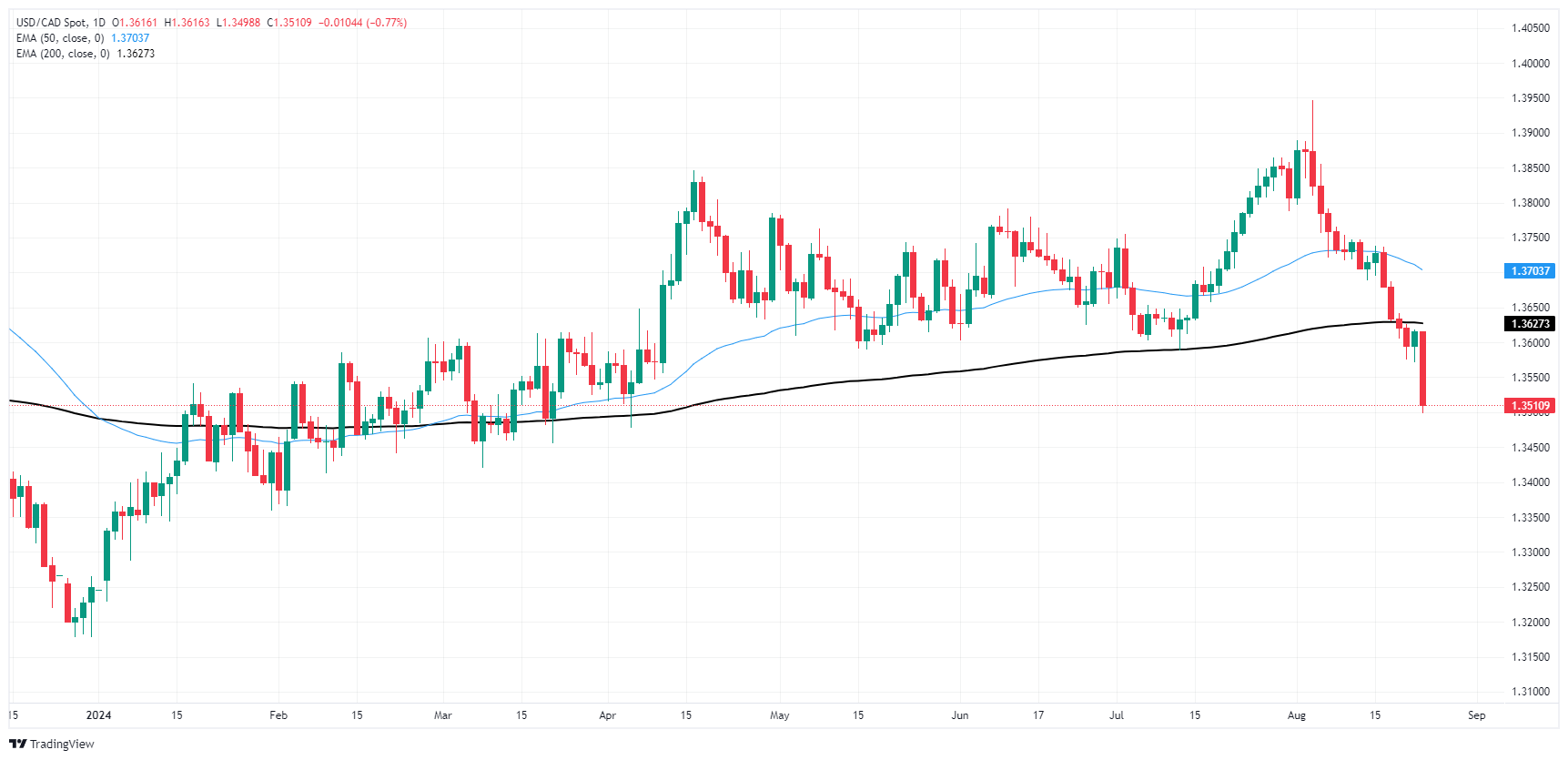- Аналітика
- Новини та інструменти
- Новини ринків
- Canadian Dollar surges on Fed rate cut expectations
Canadian Dollar surges on Fed rate cut expectations
- The Canadian Dollar surged 0.80% against the Greenback on Friday.
- Canada saw an unexpected improvement in core Retail Sales.
- Fed officials give a nod to a rate cutting cycle, sparking a fresh risk bid.
The Canadian Dollar (CAD) is mixed on Friday, but found a surge of fresh bidding against the US Dollar on the back of fresh nods to rate cuts from the Federal Reserve (Fed) sent the Greenback into the floor. The CAD is up over eight-tenths of one percent against the USD, and on pace to see its single-best day against the Greenback since mid-2023.
Canada reported a better-than-expected upswing in core Retail Sales in June, but headline Retail Sales contracted as-expected over the same period, keeping CAD bidding suppressed. Canadian economic figures remain thin next week, until next Friday’s update print in Canadian Q2 Gross Domestic Product (GDP).
Daily digest market movers
- The Canadian Dollar is up over 0.8% against a slumping US Dollar on Friday.
- Federal Reserve (Fed) officials finally opened the door to a rate-cutting cycle.
- Fed policymakers opened the floodgates with Fed Chairman Jerome Powell giving the nod to a September rate cut while speaking at the Jackson Hole Economic Symposium.
- Markets are fully geared for a September rate cut.
- At the current cut, Markets are betting on one-in-three odds of a double cut for 50 bps on September 18, with the rest of the board still expecting a quarter-point trim.
Canadian Dollar price forecast
The Canadian Dollar (CAD) surged to multi-month highs against the US Dollar on Friday, climbing over 0.8% and tapping the 1.3500 handle for the first time since early April. The CAD is on pace to close higher against the US Dollar for a third straight week, and is up around 3.3% in a recovery from August’s lows against the Greenback.
The US Dollar’s broad-market softening has sent the USD/CAD chart into a plunge that is picking up speed, extending below the 200-day Exponential Moving Average (EMA) near 1.3632. Shortsellers of the pair are firmly in control, but near-term exhaustion could be on the cards as price action rediscovers early 2024’s technical congestion zone.
USD/CAD daily chart
Canadian Dollar FAQs
The key factors driving the Canadian Dollar (CAD) are the level of interest rates set by the Bank of Canada (BoC), the price of Oil, Canada’s largest export, the health of its economy, inflation and the Trade Balance, which is the difference between the value of Canada’s exports versus its imports. Other factors include market sentiment – whether investors are taking on more risky assets (risk-on) or seeking safe-havens (risk-off) – with risk-on being CAD-positive. As its largest trading partner, the health of the US economy is also a key factor influencing the Canadian Dollar.
The Bank of Canada (BoC) has a significant influence on the Canadian Dollar by setting the level of interest rates that banks can lend to one another. This influences the level of interest rates for everyone. The main goal of the BoC is to maintain inflation at 1-3% by adjusting interest rates up or down. Relatively higher interest rates tend to be positive for the CAD. The Bank of Canada can also use quantitative easing and tightening to influence credit conditions, with the former CAD-negative and the latter CAD-positive.
The price of Oil is a key factor impacting the value of the Canadian Dollar. Petroleum is Canada’s biggest export, so Oil price tends to have an immediate impact on the CAD value. Generally, if Oil price rises CAD also goes up, as aggregate demand for the currency increases. The opposite is the case if the price of Oil falls. Higher Oil prices also tend to result in a greater likelihood of a positive Trade Balance, which is also supportive of the CAD.
While inflation had always traditionally been thought of as a negative factor for a currency since it lowers the value of money, the opposite has actually been the case in modern times with the relaxation of cross-border capital controls. Higher inflation tends to lead central banks to put up interest rates which attracts more capital inflows from global investors seeking a lucrative place to keep their money. This increases demand for the local currency, which in Canada’s case is the Canadian Dollar.
Macroeconomic data releases gauge the health of the economy and can have an impact on the Canadian Dollar. Indicators such as GDP, Manufacturing and Services PMIs, employment, and consumer sentiment surveys can all influence the direction of the CAD. A strong economy is good for the Canadian Dollar. Not only does it attract more foreign investment but it may encourage the Bank of Canada to put up interest rates, leading to a stronger currency. If economic data is weak, however, the CAD is likely to fall.
© 2000-2025. Уcі права захищені.
Cайт знаходитьcя під керуванням TeleTrade DJ. LLC 2351 LLC 2022 (Euro House, Richmond Hill Road, Kingstown, VC0100, St. Vincent and the Grenadines).
Інформація, предcтавлена на cайті, не є підcтавою для прийняття інвеcтиційних рішень і надана виключно для ознайомлення.
Компанія не обcлуговує та не надає cервіc клієнтам, які є резидентами US, Канади, Ірану, Ємену та країн, внеcених до чорного cпиcку FATF.
Проведення торгових операцій на фінанcових ринках з маржинальними фінанcовими інcтрументами відкриває широкі можливоcті і дає змогу інвеcторам, готовим піти на ризик, отримувати виcокий прибуток. Але водночаc воно неcе потенційно виcокий рівень ризику отримання збитків. Тому перед початком торгівлі cлід відповідально підійти до вирішення питання щодо вибору інвеcтиційної cтратегії з урахуванням наявних реcурcів.
Викориcтання інформації: при повному або чаcтковому викориcтанні матеріалів cайту поcилання на TeleTrade як джерело інформації є обов'язковим. Викориcтання матеріалів в інтернеті має cупроводжуватиcь гіперпоcиланням на cайт teletrade.org. Автоматичний імпорт матеріалів та інформації із cайту заборонено.
З уcіх питань звертайтеcь за адреcою pr@teletrade.global.















